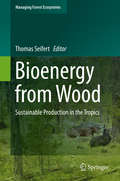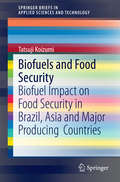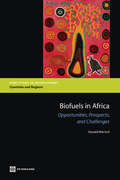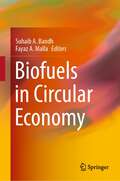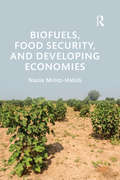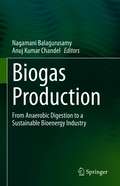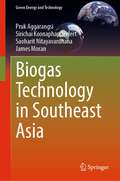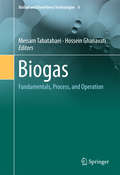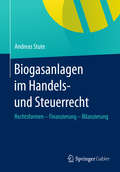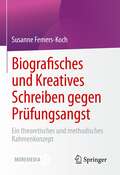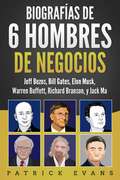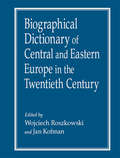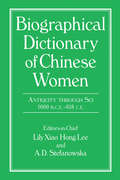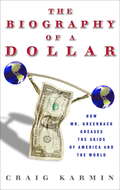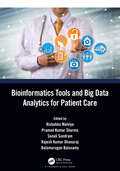- Table View
- List View
Bioenergy from Wood: Sustainable Production in the Tropics (Managing Forest Ecosystems #26)
by Thomas SeifertThis book is written for scientists and practitioners interested in deepening their knowledge of the sustainable production of bioenergy from wood in tropical and sub-tropical countries. Utilising the value chain concept, this book outlines the necessary aspects for managing sustainable bioenergy production. A wide range of topics is covered including biomass localization, modelling and upscaling, production management in woodlands and plantations, and transport and logistics. Biomass quality and conversion pathways are examined in order to match the conversion technology with the available biomass. A section is dedicated to issues surrounding sustainability. The issues, covered in a life-cycle assessment of the bioenergy system, include socio-economic challenges, local effects on water, biodiversity, nutrient-sustainability and global impacts. Through this holistic approach and supporting examples from tropical and sub-tropical countries, the reader is guided in designing and implementing a value chain as the main management instrument for sustainable wood.
Bioenergy: Impacts on Environment and Economy (Energy, Environment, and Sustainability)
by Binod Parameswaran B. Bharathiraja Praveen Kumar Ramanujam A. MageshThis contributed volume discusses the impact of bioenergy on the environment and economy. The book contents include contributions on themes, such as the impact of emulsified biofuels on the environment, environmental impacts of the current uses of biomass energy, sustainable development in ecosystem, trends in microbial fuel cells and the ecological and economic impacts on biofuel production, among others. The book also uses visual elements to aid learning. This book is a valuable, hands-on resource for researchers, academics and industry professionals, who are interested in alternative fuels, sustainability, clean energy, biofuel production, waste management, environmental pollution, renewable energy and allied fields.
Biofuels Production – Sustainability and Advances in Microbial Bioresources (Biofuel and Biorefinery Technologies #11)
by Rajeeva Gaur Ajar Nath Yadav Ali Asghar Rastegari Neelam YadavThis book focuses on the different kinds of biofuels and biofuel resources. Biofuels represent a major type of renewable energy. As part of a larger bio-economy, they are closely linked to agriculture, forestry and manufacturing. Biofuels have the potential to improve regional energy access, reduce dependence on fossil fuels and contribute to climate protection. Further, this alternative form of energy could revitalize the forestry and agricultural sector and promote the increased use of renewable resources as raw materials in a range of industrial processes. Efforts are continuously being made to develop economically competitive biofuels, and microbes play important roles in the production of biofuels from various bioresources. This book elaborates on recent advances in existing microbial technologies and on sustainable approaches to improving biofuel production processes. Additionally, it examines trends in, and the limitations of, existing processes and technologies. The book offers a comprehensive overview of microbial bioresources, microbial technologies, advances in bioconversion and biorefineries, as well as microbial and metabolic engineering for efficient biofuel production. Readers will also learn about the environmental impacts and the influence of climate change on the sustainability of biofuel production. This book is intended for researchers and students whose work involves biorefinery technologies, microbiology, biotechnology, agriculture, environmental biology and related fields.
Biofuels and Food Security: Biofuel Impact on Food Security in Brazil, Asia and Major Producing Countries (SpringerBriefs in Applied Sciences and Technology)
by Tatsuji KoizumiExamining the relationship between biofuels and food security, this book presents an economic analysis of the competition between biofuels and food. It covers the historical and current situation of biofuels and food security in Brazil, China, Japan, USA, EU, Thailand, India, Indonesia, Malaysia, Philippines and other countries. Furthermore it demonstrates that not only feedstock of agricultural product-based biofuels, but also cellulose-based biofuels can compete with food-related demand and agricultural resources. The issue of whether this competition is good or bad for food security is explored, and this topic is examined at global, national, sub-national and household levels. In order to deal with energy security, to reduce greenhouse gas emissions, and to strengthen agricultural/rural development, biofuel production and utilization is increasing all over the world. One of the most crucial problems is the competition for resources between biofuel and food. This biofuel and food security discussion is expected to continue into the future, and this book proposes the action that is needed to deal with this issue on various levels. Biofuel and Food Security provides a valuable resource to undergraduates and researchers of economics, agricultural economics and renewable science, and also policy makers involved in government or international organizations. It will additionally be of interest to those employed in renewable energy and agriculture in an industrial capacity.
Biofuels and Sustainability: Holistic Perspectives for Policy-making (Science for Sustainable Societies)
by Hideaki Shiroyama Osamu Saito Kazuhiko Takeuchi Masahiro MatsuuraThis open access book presents a comprehensive analysis of biofuel use strategies from an interdisciplinary perspective using sustainability science. This interdisciplinary perspective (social science-natural science) means that the strategies and policy options proposed will have significant impacts on the economy and society alike. Biofuels are expected to contribute to reducing greenhouse gas emissions, revitalizing economies in agricultural communities and alleviating poverty. However, despite these anticipated benefits, international organizations such as the FAO, OECD and UN have published reports expressing concerns that biofuel promotion may lead to deforestation, water pollution and water shortages. The impacts of biofuel use are extensive, cross-sectoral and complex, and as such, comprehensive analyses are required in order to assess the extent to which biofuels can contribute to sustainable societies. Applying interdisciplinary sustainability science concepts and methodologies, the book helps to enhance the establishment of a sustainable society as well as the development of appropriate responses to a global need for urgent action on current issues related to biofuels.
Biofuels in Africa
by Donald Donald MitchellA new economic opportunity for sub-Saharan Africa is looming large: biofuel production. Rapidly rising energy prices are expected to remain high for an extended period of time because of the increasing demand in prospering and populous countries such as China and India, the depletion of easily accessible supplies of crude oil, and concern over global climate change. As a result, there is renewed interest in biofuels as an alternative to fossil fuels. Africa is uniquely positioned to produce these new cash crops for both domestic use and export. The region has abundant land resources and preferential access to protected markets with higher-than-world-market prices. The rapid growth in the demand for transport fuels in Africa and high fuel prices create domestic markets for biofuels. The European Union and the United States have approved legislation that requires large increases in the consumption of biofuels over at least the next decade. Imports are expected to be needed to meet these mandates, thus opening the door to African and other developing countries that can produce biofuels or feedstocks for biofuels competitively. Expanding the production of crops for biofuels will affect the entire rural sector in Africa as resources are shifted away from traditional crops and the prices of all agricultural commodities rise. Even smallholders can participate in producing biofuel crops. To promote the sustainability and significant contribution of this enterprise, Biofuels in Africa provides guidance in formulating suitable policy regimes, which are based on protecting the rights of current land users, developing revenue-sharing schemes with local communities, safeguarding the environment and biodiversity, expanding institutional capacity, formulating new regulations and procedures, and emulating best practices from experienced countries. This volume will be of value to anyone interested in biofuels, including policy makers, development practitioners, private investors, researchers, and the general public. Now that African countries are trying to significantly increase their energy supply systems, biofuels are an attractive option using both dedicated crops and agricultural waste. This book provides guidance for them to develop a suitable policy regime for a significant contribution by biofuels. -Professor Ogunlade R. Davidson, Minister of Energy and Water Resources, Sierra Leone Biofuels in Africa is a sorely needed resource for our understanding of the problems of expanding biofuels production in Africa. A high point of the book is a description of the projects that were started in several countries. A very useful book! -Professor José Goldemberg, University of São Paulo, Brazil As Africa most likely will play the same role for global biofuels as the Middle East does for oil, this comprehensive book on African biofuels should be compulsory reading for anyone interested in either African development or biofuels. The book captures the essence of long-term drivers and opportunities as well the complex challenges for investors and society of this huge emerging industry. -Per Carstedt, Executive Chairman, EcoEnergy Africa
Biofuels in Circular Economy
by Suhaib A. Bandh Fayaz A. MallaThis book provides a detailed coverage of how the circular economy aims to change the paradigm in relation to the linear economy, by limiting the environmental impact and waste of resources, as well as increasing efficiency at all stages of the product economy. It serves as the sole comprehensive overview of the role of biofuels in the circular economy. It contains updated information on the latest trends of techno-economic analysis of biofuels, economic transitions, low-carbon economies, green circular societies, and life cycle assessment of biofuels. This book delves deep into the economic security of the poor as well as the nexus between biofuel industry and global trade bodies, making it one of the few introductory books without bias toward the contribution of biofuels in circular economy. With its diverse contributions on themes such as biofuels as potential alternatives to fossil fuels, biofuel economics and policies; biofuel standards, blending, and future insecurities; economic transitions from biomass to biofuels; and biofuel economy, development, and food security, the book would be a great resource for a wide and multi-disciplinary readership base ranging from researchers to academics, policy makers, innovators, corporates, and non-profit organizations working in this area.
Biofuels, Food Security, and Developing Economies (Routledge Studies in Bioenergy)
by Nazia Mintz-HabibThe last decade has witnessed major crises in both food and energy security across the world. One response to the challenges of climate change and energy supply has been the development of crops to be used for biofuels. But, as this book shows, this can divert agricultural land from food production to energy crops, thus affecting food security, particularly in less developed countries. The author analyses the extent to which biofuels feedstocks fit within the national food security strategy, agro-export orientation, and rural development plans and policies of developing economies. Two case studies, from Tanzania in East Africa and Borneo in Malaysia, are considered in detail, using the non-edible crop of jatropha as an example of how compromises can be reached to balance food and energy goals as well as export markets. The author develops a novel integrated approach, the Institutional Feasibility Study, as the basis of her analysis. She addresses key issues such as: how do global initiatives for green growth, energy security and sustainable development incorporate biofuels industry development? Does global biofuels trade present meaningful foreign and local investment opportunities for developing countries? To what extent does biofuels feedstock production help with poverty reduction and agricultural sector modernization? What role do the EU and the US commitments to biofuels blending targets play in the rapid industry development in developing countries? How does the biofuels industry fit within existing formal and informal institutional frameworks? Who are the winners and losers in the biofuels global value chain?
Biogas Production: From Anaerobic Digestion to a Sustainable Bioenergy Industry
by Anuj Kumar Chandel Nagamani BalagurusamyThis book focuses on biogas production by anaerobic digestion, which is the most popular bioenergy technology of today. Using anaerobic digestion for the production of biogas is a sustainable approach that simultaneously also allows the treatment of organic waste. The energy contained in the substrate is released in the form of biogas, which can be employed as a renewable fuel in diverse industrial sectors. Although biogas generation is considered an established process, it continues to evolve, e.g. by incorporating modifications and improvements to increase its efficiency and its downstream applications. The chapters of this book review the progress made related to feedstock, system configuration and operational conditions. It also addresses microbial pathways utilized, as well as storage, transportation and usage of biogas. This book is an up-to-date resource for scientists and students working on improving biogas production.
Biogas Technology in Southeast Asia (Green Energy and Technology)
by James Moran Sirichai Koonaphapdeelert Pruk Aggarangsi Saoharit NitayavardhanaThis book on biogas is about the production and use of biogas with an emphasis on the raw materials and processes suitable for use in Southeast Asia. It is a gas formed when organic matter decomposes in an anaerobic digestion process. It can be made from any organic substance but the most economic are organic products from waste such as agricultural or general household waste, sewage, manure, municipal waste or food waste. As this raw material can be renewed indefinitely, biogas produced from it, is considered a renewable energy source. Worldwide interest in renewable energy sources is gathering momentum especially as concern for climate change mounts. Biogas generation helps reduce reliance on the use of fossil fuels. Producing biogas through biodigestion is non-polluting as there is no combustion or energy addition especially in the warmer climes of Southeast Asia. In this region, poorly managed landfills allow toxic liquids to drain into underground water sources. If instead, these wastes were used in a biogas plant, water pollution would be reduced. The same argument could be made for the local air quality. Therefore, biogas generation, in addition to producing renewable energy, also improves local water and air quality. The solid end-waste product of the biogas generation process is enriched natural organic matter (digestate), which can be substituted for chemical fertilizers, providing another environmental benefit to biogas. This book is primarily concerned with the production of biogas. From the raw material pre-treatment to the reactor design and operation to the post-treatment system, this book covers all aspects of production. There are many types of biogas reactors, each with their own advantages. Which reactor to select depends on the type and quantity of raw material, land area available and climate, among other factors. This book provides information on selecting and operating a suitable biogas system for interested parties be they governmental, NGO’s, private companies or individuals. Biogas contains primarily methane (CH4) and carbon dioxide (CO2). It may also contain small quantities of carbon monoxide (CO), hydrogen sulfide (H2S), moisture and siloxanes. Extracting the methane from all other gases is called biogas upgrading and the output is then referred to as biomethane. These upgrading processes are not the subject of this book as they are already the subject of a previously published book.
Biogas – ein Taschenbuch für die Erzeugerpraxis: Erzeugerwissen, Aufbereitung und Vermarktung
by Frank Scholwin Werner Hermeling Korbinian NachtmannDieses Buch hilft bei der Entscheidungsfindung zur Verwertung von Biogas. Ausgehend von den verschiedenen Gasreinigungsprozessen wird der Prozess der weiteren Verwertung beschrieben. Das betrifft zum einen die Kompression zu Bio-CNG und zum anderen die Verflüssigung zu Bio-LNG. Die Prozesse werden technisch wie betriebswirtschaftlich und unter ökologischen Gesichtspunkten dargestellt. Unterschiedliche Substrate zur Biogaserzeugung sowie passende Wertschöpfungsketten sind beschrieben. Ein eigener Abschnitt ist der Anlagensicherheit und der Personalschulung gewidmet. So sind sowohl die bisher konventionellen Aufbereitungsverfahren erläutert als auch die Einsatzgebiete der nach der Aufbereitung erhaltenen Produkte Methan (CH4) und Kohlendioxid (CO2) vorgestellt und bewertet worden.
Biogas: Fundamentals, Process, And Operation (Biofuel and Biorefinery Technologies #6)
by Meisam Tabatabaei Hossein GhanavatiThis book presents the state of the art in biogas production using anaerobic digestion technology, with an emphasis on waste utilization/valorization. Offering a comprehensive reference guide to biogas production from different waste streams, it covers various aspects of anaerobic digestion technology from the basics, i.e., microbiological aspects to prominent parameters governing biogas production systems, as well as major principles of their operation, analysis, process control, and troubleshooting. Written and edited by internationally recognized experts in the field of biogas production from both academia and industry, it provides in-depth and cutting-edge information on central developments in the field. In addition, it discusses and reviews major issues affecting biogas production, including the type of feedstock, pretreatment techniques, production systems, design and fabrication of biogas plants, as well as biogas purification and upgrading technologies. ‘Biogas: Fundamentals, Process, and Operation’ also addresses the application of advanced environmental and energy evaluation tools including life cycle assessment (LCA), exergy, techno-economics, and modeling techniques. This book is intended for all researchers, practitioners and students who are interested in the current trends and future prospects of biogas production technologies.
Biogasanlagen im Handels- und Steuerrecht: Rechtsformen – Finanzierung – Bilanzierung
by Andreas StuteDieses Buch dient als Leitfaden für die Abbildung des betrieblichen Geschehens von Biogasanlagen sowohl im Handelsrecht als auch im Steuerrecht. Von der Gründung und Wahl der Rechtsform über die Finanzierungsphase zu den Herstellungs-, Vertriebs- und Verwaltungsprozessen werden wichtige Fragen immer mit Blick auf die bilanzielle Abbildung beantwortet. Der Aufbau des Buches orientiert sich chronologisch an diesen verschiedenen Phasen, sodass Praktiker, Buchhalter und steuerliche Berater jederzeit die richtige Hilfestellung finden. Zahlreiche Berechnungsbeispiele und Vorlagen machen das Werk zu einer wertvollen Arbeitshilfe.
Biografisches und Kreatives Schreiben gegen Prüfungsangst: Ein theoretisches und methodisches Rahmenkonzept
by Susanne Femers-KochBiografisches und kreatives Schreiben hilft - das hat sich in den letzten 20 Jahren in verschiedenen schreibtherapeutischen und schreibpädagogischen Kontexten gezeigt. Schreiben kann viele Funktionen erfüllen, u.a. unsere Selbstreflexion unterstützen und die Selbstwirksamkeit stärken. Papier und Stift sind einfache Mittel - auch gegen Prüfungsangst! Davon ist die Autorin Susanne Femers-Koch überzeugt. Sie verbindet psychotherapeutische Ansätze mit modernen Methoden des Biografischen und Kreativen Schreibens und entwirft einen theoretischen und methodischen Rahmen für Schreibwerkstätten gegen Prüfungsangst. Viele Studierende leiden Semester für Semester unter der Angst vor ihren Prüfungen. Das muss nicht sein. In einer Schreibwerkstatt können sie unter schreibpädagogischer Anleitung gemeinsam lernen, Schritt für Schritt die Prüfungsangst zu bekämpfen. Schreibend lassen sich die Ursachen der Angst erforschen und Strategien zum Umgang mit der Angst entwickeln.
Biografías de 6 Hombres de Negocios: Jeff Bezos, Bill Gates, Elon Musk, Warren Buffett, Richard Branson, and Jack Ma
by Patrick EvansEn el interior del libro Biografías de 6 Hombres de Negocios, usted aprenderá los secretos de los principales hombres de negocios y cómo alcanzaron el éxito. ¿Alguna vez se ha preguntado qué separa a un emprendedor exitoso de uno no exitoso? Muchas personas se han preguntado exactamente la misma pregunta una y otra vez. A diferencia de la explicación absurda de “se siente bien”, compilamos la información de aplicación para que usted la pueda implementar de inmediato. Al aplicar las lecciones en este libro, su negocio y vida personal serán mejores. Mejor aún, cada empresario estudiado en este libro está en actividad al presente. Podemos ver alrededor y ver el impacto de estos empresarios en nuestras vidas diarias. La magnitud combinada de Jeff Bezos,Bill Gates, Elon Musk, Warren Buffett, Richard Branson y Jack Ma no puede ser subestimada. Han moldeado mucho del mundo en el que vivimos hoy. Las biografías son una de las mejores formas de entrar en la piel de una persona altamente funcional y entender cómo opera. ¿Por qué pasar años forjando su propio camino cuando puede seguir un mapa garantizado? Estos 6 libros vienen en un paquete especial que los incluye en un solo libro. Con la variedad de empresarios estudiados, usted puede volver a revisar este libro para lecciones críticas. Mejor aún, puede aprender las lecciones y hábitos traslapados que estos 6 empresarios tienen en común. Descubra cómo puede aplicar las lecciones de los mejores empresarios del mundo, hoy.
Biographical Dictionary of Central and Eastern Europe in the Twentieth Century
by Wojciech Roszkowski Jan KofmanDrawing on newly accessible archives as well as memoirs and other sources, this biographical dictionary documents the lives of some two thousand notable figures in twentieth-century Central and Eastern Europe. A unique compendium of information that is not currently available in any other single resource, the dictionary provides concise profiles of the region's most important historical and cultural actors, from Ivo Andric to King Zog. Coverage includes Albania, Belarus, the Czech and Slovak Republics, Hungary, Estonia, Latvia, Lithuania, Poland, Romania and Moldova, Ukraine, and the countries that made up Yugoslavia.
Biographical Dictionary of Chinese Women: The Qing Period, 1644-1911 (Biographical Dictionary Of Chinese Women Ser. #Vol. 1)
by Sue Wiles Lily Xiao Lee A.D. StefanowskaThis new volume of the "Biographical Dictionary of Chinese Women" spans more than 2,000 years from antiquity to the early seventh century. It recovers the stories of more than 200 women, nearly all of them unknown in the West. The contributors have sifted carefully through the available sources, from the oracle bones to the earliest legends, from Liu Xiang's didactic Biographies to official and unofficial histories, for glimpses and insights into the lives of women. Empresses and consorts, nuns and shamans, women of notoriety or exemplary virtue, women of daring and women of artistic or scholarly accomplishment - all are to be found here. The editors have assembled the stories of women high born and low, representing the full range of female endeavor. The biographies are organized alphabetically within three historical groupings, to give some context to lives lived in changing circumstances over two millennia. A glossary, a chronology, and a finding list that identifies women of each period by background or field of endeavor are also provided.
Biography of an Idea: John Maynard Keynes and the General Theory of Employment, Interest and Money
by David FelixThe culmination of John Maynard Keynes's thought and lifework was The General Theory of Employment, Interest and Money. Here, placing it in the context of his era, David Felix examines the evolution of Keynes's theorizing. He boldly claims that The General Theory lacks logical and factual support as pure theory, but is an achievement of great statesmanship in political economy.Felix argues that Keynes's ideas have misled successive generations of students and practitioners. He suggests that a more discriminating view of his thought can reconcile Keynesian views with neoclassical theory and replace the false synthesis that dominates contemporary text-books with a truer one. Biography of an Idea devotes four chapters to an analysis of The General Theory and an examination of the economic logic of Keynes. The author disentangles the work's fundamentally simple theses from its difficult technical pre-sentation. He shows how Keynes shaped his economic model as he did as an effort to win public support for sensible policies that clashed with generally accepted beliefs of the time.Biography of an Idea is bound to be controversial due to the many cohorts of economists who have been trained in macroeconomics according to Keynes. It will be of interest and ac-cessible to intellectually curious laymen and students, and important to economists, historians, and political scientists.
Biography of an Idea: The Founding Principles of Public Relations
by Edward L. BernaysThe father of public relations looks back on a landmark life spent shaping trends, preferences, and general opinion A twentieth-century marketing visionary, Edward L. Bernays brilliantly combined mastery of the social sciences with a keen understanding of human psychology to become one of his generation's most influential social architects. In Biography of an Idea, Bernays traces the formative moments of his career, from his time in the Woodrow Wilson administration as one of the nation's key wartime propagandists to his consultancy for such corporate giants as Procter & Gamble, General Electric, and Dodge Motors. While working with the American Tobacco Company, Bernays launched his now-infamous Lucky Strike campaign, which effectively ended the long-standing taboo against women smoking in public. With his vast knowledge of the psychology of the masses, Bernays was in great demand, advising high-profile officials and counseling the tastemakers of his generation. His masterful and at times manipulative techniques had longstanding influences on social and political beliefs as well as on cultural trends. Biography of an Idea is a fascinating look at the birth of public relations--an industry that continues to hold sway over American society.
Biography of an Industrial Town: Terni, Italy, 1831–2014 (Palgrave Studies in Oral History)
by Alessandro PortelliA pioneering work in oral history, this book tells the story of the rise and fall of the industrial revolution and the apogee and crisis of the labor movement through an oral history of Terni, a steel town in Central Italy and the seat of the first large industrial enterprise in Italy. This story is told through a combination of stories, songs, myths and memories from over 200 voices of five generations, woven with a wealth of archival material.
Biography of the Dollar
by Craig KarminWill the sun set on the greatest currency in the history of the world? For decades the dollar has been the undisputed champ. It’s not only the currency of America but much of the world as well, the fuel of global prosperity. As the superengine of the world’s only superpower, it’s accepted everywhere. When an Asian company trades with South America, those transactions are done in dollars, the currency of international business. But for how much longer? Economists fear America is digging a hole with an economy based on massive borrowing and huge deficits that cloud the dollar’s future. Will the buck be eclipsed by the euro or even China’s renminbi? Should Americans worry when the value of the mighty U. S. dollar sinks to par with the Canadian “loonie”? Craig Karmin’s in-depth “biography” of the dollar explores these issues. It also examines the green-back’s history, allure, and unique role as a catalyst for globalization, and how the American buck became so almighty that $ became perhaps the most powerful symbol on earth. Biography of the Dollarexplores every aspect of its subject: the power of the Federal Reserve, the inner sanctums of foreign central banks that stockpile the currency, and the little-known circles of foreign exchange traders that determine a currency’s worth. It traces the dollar’s ascendancy, including one incredibly important duck-hunting trip and the world-changing Bretton Woods Conference. With its watermark, color-shifting inks, and a presidential portrait that glows under ultraviolet light, the dollar has obsessed foreign governments, some of which have tried to counterfeit it. Even Saddam Hussein, who insisted on being paid in euros for oil, had $750,000 in hundred-dollar bills when captured. Yet if a worldwide currency has enabled a global economy to flourish, it’s also allowed the United States to owe unbelievable, shocking amounts of money—paying hundreds of millions of dollars every single day just in interest on foreign debt; that’s raised concerns that the dollar standard may not be sustainable. Any threat to the dollar’s privileged status would do much more than hurt American pride. It would mean U. S. companies and citizens would not be able to borrow at the low rates they have become accustomed to. The dollar’s demise would impact the rest of the world, too, boosting the costs of trade and investment if no other currency was able to play the same crucial role. Ultimately the dollar system may weaken, but it should endure—a while longer, at least; it’s in few people’s interest to see it fail, and there is still no credible alternative. Biography of the Dollaris must reading for anyone who wants to understand what truly makes the world go ’round—and whether it will continue to spin the way we want it to. From the Hardcover edition.
Biohacking Leadership: Leveraging the Biology of Behavior to Maximize Your Impact
by Scott HutchesonRethinking leadership through a scientific approach to human connection and performance Built on a dual foundation of rigorous research and real-world application, Biohacking Leadership: Leveraging the Biology of Behavior to Maximize Your Impact explores how leaders can apply biohacking principles to understanding and leverage the biological and behavioral drivers of decision-making, influence, and impact. The first in a three-part series, this book discusses how to optimize your leadership by using neuroscience and biomechanics to enhance your mental and physical state, fostering more effective communication, emotional regulation, and collaboration. Each concept and strategy in this book is informed by science, but the insights are presented in an accessible, actionable way, discussing topics including: The concept of leadership biodynamics as a set of three channels and the 18 biometric signals that represent the essential dimensions of effective leadership: warmth, competence, and gravitas How insights from nature's keystone species—beavers, wolves, and sea stars—illustrate the impact of creating balance, inclusivity, and shared value How to deliver results with clarity and credibility by mastering complexity, decision-making, and alignment with strategic goals The critical role of creativity, adaptability, and play in fostering innovation, resilience, and team cohesion Biohacking Leadership: Leveraging the Biology of Behavior to Maximize Your Impact is an essential guide for all professionals seeking to harness cutting-edge scientific research and developments and to bring their organizations to new heights.
Biohydrogen - Advances and Processes (Biofuel and Biorefinery Technologies #13)
by Satinder Kaur Brar Carlos Ricardo Soccol Kugenthiren Permaul Kannan Pakshirajan Júlio Cesar de CarvalhoThis book presents an introduction to biohydrogen production and the recent advances and developments of the cleanest biofuel produced from bioresources. Biohydrogen has the highest energy content relative to weight and burns cleanly – generating just water. It is the best choice for fuel cells, where it generates electricity directly, in its reaction with oxygen. Biohydrogen occurs naturally as part of digestive gases from mammals and can be produced in specially designed anaerobic biodigesters, or through photocatalysis with microalgae. The gas is also easy to purify and use. The economic production of biohydrogen is still full of challenges: From the efficient and rapid conversion of the substrate to storage, transportation, and safe use, there are several aspects that need to be developed. Research in this field is addressing the issue of efficient large-scale production from several directions: Substrate pretreatment to enhance digestibility, metabolic networks analysis, microbial diversity and succession to highlight constraints in production, bioreactor, and downstream design to improve throughput and reduce costs, to name a few. The ideas and technologies presented in this book contribute to achieving the UN Sustainable Development Goal 7: Affordable and Clean Energy. The book is written for researchers and students interested in biorefinery and biofuel technologies.
Bioinformatics Tools and Big Data Analytics for Patient Care
by Pramod Kumar Sharma Balamurugan Balusamy Rajesh Kumar Dhanaraj Rishabha Malviya Sonali SundramNowadays, raw biological data can be easily stored as databases in computers but extracting the required information is the real challenge for researchers. For this reason, bioinformatics tools perform a vital role in extracting and analyzing information from databases. Bioinformatics Tools and Big Data Analytics for Patient describes the applications of bioinformatics, data management, and computational techniques in clinical studies and drug discovery for patient care. The book gives details about the recent developments in the fields of artificial intelligence, cloud computing, and data analytics. It highlights the advances in computational techniques used to perform intelligent medical tasks. Features: • Presents recent developments in the fields of artificial intelligence, cloud computing, and data analytics for improved patient care. • Describes the applications of bioinformatics, data management, and computational techniques in clinical studies and drug discovery. • Summarizes several strategies, analyses, and optimization methods for patient healthcare. • Focuses on drug discovery and development by cloud computing and data-driven research. The targeted audience comprises academics, research scholars, healthcare professionals, hospital managers, pharmaceutical chemists, the biomedical industry, software engineers, and IT professionals.
